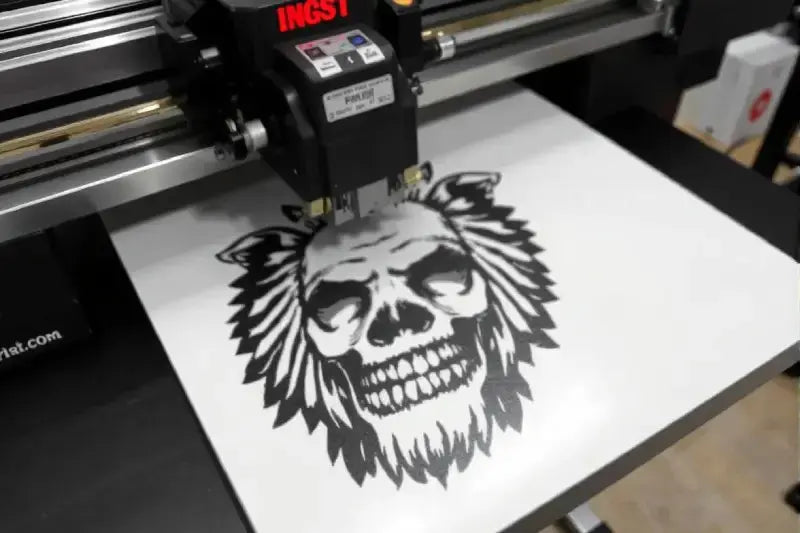If you've been doing DTF (Direct to Film) printing for some time, you know the feeling of making awesome, pro-grade designs. Seeing your art on clothes is really cool. However, even the best designs can be compromised by factors like humidity and incorrect DTF printing temperature settings.
You can have a great printer and good film, but still get blurry edges or transfers that don't stick right. A lot of the time, the problem isn't your transfer, it's the room you're working in and how you've set up your heat press. DTF printer room temperature can change everything, even when your setup looks perfect.
So, let's talk about why humidity and heat mess with your DTF prints and how to stop it from happening. Understanding DTF printing environment conditions is often the missing piece to getting reliable results.
How Humidity effects on DTF printing Ruin Prints
DTF inks have water in them, so they react to the moisture in the air. Your room's humidity changes how the ink acts when you're printing, drying it, and transferring it. Learning how to control humidity in print shop spaces is one of the best things you can do for quality.
When humidity is high (over 60%), the ink can stay sticky too long. That leads to:
-
Ink smearing when you're putting on powder or pressing.
-
Hot melt powder sticks together because it's absorbing water.
-
Transfers are not sticking well when you use the heat press.
Low humidity (under 35–40%) is also bad. The air gets dry and makes static electricity. That makes the film lift or move a bit when you're pressing, and that leaves shadows or blurry stuff. It's one of the big reasons why your prints can look good sometimes and bad other times. Temperature and humidity in heat pressing work together, so controlling both matters is crucial.
Why Temperature Settings Go Wrong and How to Fix Them
How hot your heat press is also super important. DTF transfers need heat to melt the powder, stick the ink to the fabric, and let the film come off easily. Ignoring heat press temperature fluctuations can lead to distorted prints that cannot be redone.
If your press is too hot, you might:
-
Melt the powder too much, which makes the edges blurry.
-
Have ink bleed into the fabric.
- Have the film warp a little, which messes up the alignment.
If your press isn't hot enough:
-
The powder won't melt all the way.
-
The ink might not stick, so the design peels or cracks after washing.
- Transfers look weak because the ink didn't get hot enough.
Every film and powder requires proper heat settings, but the humidity and temperature around your press can change things. So, even if you use the right settings, they might not work if the room is too hot, cold, wet, or dry. These small DTF print quality issues often come from changes you can barely feel.
The Double Problem: Humidity and Heat
High humidity and high temperature are a bad mix: the ink is soft and sticky, and the film overheats, which makes things stick together, smear, or ghost. This is why you should always keep DTF printing troubleshooting tips handy.
Low humidity and high temperature mean more static, which makes the film jump when you open the press.
Low humidity and low temperature often mean the design doesn't stick completely, so it looks faded or peels off later.
That's why you need to control both humidity and heat, not just one. Finding the best temperature for DTF transfers depends on balancing both factors every day.
Signs Your Room Is Hurting Your Prints
You might think your press is broken or your film is bad, but it could be the air. Look for these signs:
-
Transfers feel sticky after pressing.
-
The film sticks to itself or the fabric when you peel it.
-
Blurry edges or faint double images.
-
Powder sticks together or doesn't come off clean.
- Designs look dull even if you use the right temperature.
These signs usually mean the humidity or heat settings are wrong. Controlling your room temperature can help you avoid DTF transfer warping that sneaks up during busy days.
What to Do About Humidity
Step 1: Measure It
Get a cheap digital hygrometer. Place it near your press and printer to monitor the daily humidity. It’s the easiest fix for moisture problems in DTF printing that cost you time and money.
Step 2: Find the Right Level
For most DTF setups, you want 40–60% humidity. Less than that, and you get static; more than that, and the ink stays too soft.
Step 3: Add or Remove Moisture
If it's winter or you live in a dry place, use a humidifier. If you live somewhere humid, use a dehumidifier or air conditioner to keep the humidity steady.
Step 4: Store Stuff Right
Keep films, powders, and transfers you aren't using in closed plastic containers with silica gel packs. That stops them from absorbing water or drying out too much. Storing your supplies at the proper storage temperature for DTF films keeps them working like new.
Fixing the humidity is cheap, but it makes a huge difference.
What to Do About Heat Press Temperature
Step 1: Set Up Your Press
Heat presses aren't always accurate. Use a heat gun or thermometer to check the actual temperature of the plate. Adjust your settings to match the thermometer's reading. This simple step helps you maintain awareness of your DTF printer room temperature, ensuring consistency.
Step 2: Follow the Film's Rules, Then Test
Every film brand recommends a temperature and time. Try that first, but do test prints to get it just right.
Step 3: Check the Pressure
Good heat isn't enough if you don't have good pressure. Medium to firm pressure usually works best for DTF.
Step 4: Don't Overheat
Don't think hotter is always better. If you overheat the powder, it melts too much and makes the design blurry or warps the film.
Daily Routine to Prevent Wrong DTF Printing Temperature Settings
-
Turn on your press and let it heat up all the way before printing.
-
Check the humidity every morning.
-
Do a test print on scrap fabric when you get new rolls of film, a new kind of powder, or when the weather changes.
-
Write down the temperature and humidity that made your best prints.
- Keep powders dry by closing them up right after you use them. Small habits keep DTF printing environment conditions from changing your results.
-
Use heat-resistant tape to stop the film from moving
-
Peel slowly and evenly – fast peels make more static
-
Print in a room without wind (like from AC vents)
-
Keep finished transfers flat until you use them
-
Buy good film and powder – they react better to changes in the room
These little steps can help you save both time and money and expensive reprints.
Final Thoughts
Humidity and heat press temperature aren't just small things – they really change how your ink, powder, and film act. If you ignore them, you'll get blurry prints, peeling, and unhappy customers.
The good news is, it's not hard to control DTF printing environment conditions. A hygrometer, a heat gun, and better habits can make your prints way better really fast. DTF printing is part art and part knowing what you're doing – and knowing what you're doing starts with understanding your workspace.
By learning about humidity and temperature, you can keep your prints sharp, tough, and professional every time. Ready to test some DTF samples? Try our DTF Sample Pack and check how your room's temperature reacts with DTF transfers.

